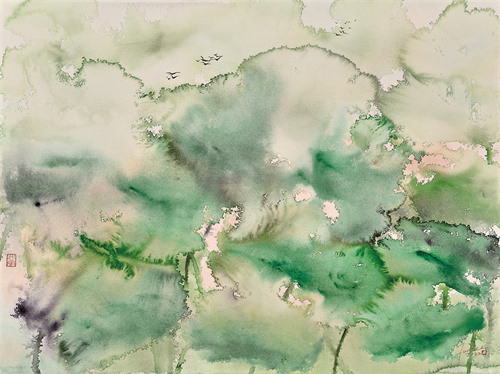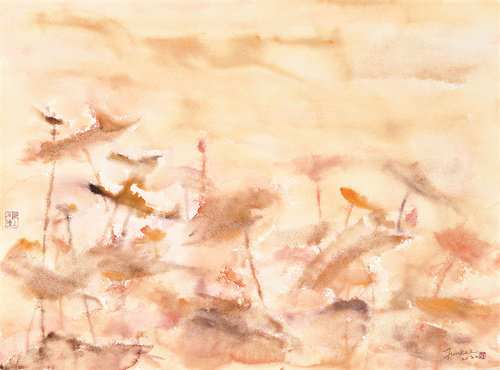Residence of Gentleman
The lotus is regarded as the flower of the gentleman, which originated from Zhou Dunyi's famous poem "Ode to the Lotus" in the Song Dynasty, "I only like the lotus because it comes out of the mud and does not become stained. It is clear and clean but not demonic. Its stem runs through the middle and has a straight shape. It does not grow vines or branches. Its aroma spreads more fragrant. It is clean and stands straight in the water. It can be viewed from a distance but cannot be played with profanities. I think the chrysanthemum is a hermit among flowers; the peony is a rich and noble flower; the lotus is a gentleman among flowers." Lotus is noble and self-sufficient, proud and independent. It has the character of a gentleman. "Unimpeded inside" it means no pain of depression. "Outwardly straight" means people can achieve the realm of righteousness and awe-inspiring only when they have no worldly desires. "Fragrance is far and clear" symbolizes the virtue of a gentleman, such as the fragrance of flowers spreading far and wide, and affects people.
The etiquette of a gentleman has been recorded in the pre-Qin period. In "The Book of Songs", jade is used as a symbol of a gentleman, "Mr. elegant is a real gentleman, with beautiful jade hanging around his ears and the jewel inlaid cap shining like a star." A gentleman is as gentle as jade, and his good virtues are like jade ornaments, which make people shine. In this series, the gentleman's posture of the lotus is shown. There is not only the fragrant beauty of "Lotus with a smile and the fragrant wind" (Shen Ying's "Painting Spring (Lotus in the Wind)"), but also the softness and color of "The lotus root is as white as jade and snow, with delicate and transparent apertures in the middle, which is exquisite and lovely. Its green leaves and red flowers spread over the water and are set off against each other." (Wu Shidao's "Lotus Root, Flower and Leaves") The light and elegant tones of the watercolor painting render the freshness and pleasantness of the lotus pond. The flowing colors interweave into a dreamlike lotus pond, with fields of lotus leaves and fragrant flowers. Like a gentleman, the lotus is independent and full of virtue.
Watercolor painting belongs to the category of Western painting. It is a kind of "representation" art. The painter uses pigments to depict nature, uses colors to express light and shadow, and uses texture to express structure. While Chinese painting is the art of "expression", traditional Chinese painting emphasizes "depicting spirit with form". It pursues a feeling of "wonderful between likeness and dissimilarity". It emphasizes that the interest of brush and ink is the inner monologue of the painter. To me, the lotus pond is a faithful friend. She generously shares the refreshing summer with me and listens to my inner monologue. I want to interpret the lotus pond in a new way, which is not only a "reappearance" of nature, but also a "performance" based on my emotions. It integrates China and the West, running through ancient and modern times. As Zhang Ruoxu sighed in "Spring River, Flowers and Moon Night", "People would still come and go after generations. The river and the moon look the same year after year." The lotus pond seen today, just like the lotus pond seen by the ancients thousands of years ago, is full of eternal vitality. The unique style of watercolor painting and the virtue of gentleman in Chinese traditional culture are integrated into the picture, writing a new chapter of the summer lotus pond.
君子攸寧
蓮被視為君子之花,源於宋代周敦頤的名篇《愛蓮說》:“予獨愛蓮之出淤泥而不染,濯清漣而不妖,中通外直,不蔓不枝,香遠益清,亭亭淨植,可遠觀而不可褻玩焉。予謂菊,花之隱逸者也;牡丹,花之富貴者也;蓮,花之君子者也。”蓮花高潔自守,傲然獨立,有君子之風骨;“中通”,乃無鬱結之苦,“外直”,則無欲則剛,“香遠益清”象徵君子的美德如花香遠播,感化眾人。
君子之儀,在先秦時期就已有記載,《衛風·淇奧》中將玉器作為君子的象徵:“有匪君子,充耳琇瑩,會弁如星。”君子溫潤如玉,良善的美德如同玉石佩飾,使人熠熠生輝。這個系列中,展現了蓮的君子之姿,既有“荷花含笑調薰風”(沈瀛《畫堂春(風中荷花)》)的芬芳惠然,又有“玉雪竊玲瓏,紛披綠映紅”(吳師道《蓮藕花葉圖》)的柔美繽紛。水彩畫淡雅的色調渲染出荷塘的清新怡人,流動的色彩交織出如夢似幻的荷塘萬象,蓮葉田田,花香四溢,蓮如君子一般猗猗獨立,德音滿盈。
水彩畫屬於西洋畫的範疇,是一種“再現”藝術,畫家用顏料描繪自然,用色彩表現光影,用肌理表現質感。而中國畫是“表現”的藝術,傳統中國畫講求“以形寫神”,追求一種“妙在似與不似之間”的感覺,強調筆墨之趣是畫家內心的獨白。荷塘於我,是一位忠實的朋友,她慷慨地向我分享盛夏的清爽,傾聽我的內心獨白。我想以一種全新的方式來詮釋荷塘,這既是一種對自然的“再現”,亦是基於我的情感所做出的“表現”;它融匯中西,貫穿古今,正如張若虛在《春江花月夜》中所感歎的那樣,“人生代代無窮已,江月年年望相似。”今日所見之荷塘,正如千百年前古人所見的荷塘一樣,煥發著歷久彌新的生機,水彩畫的獨特風格與中國傳統文化中的君子之德融匯於畫面中,譜寫出夏日荷塘的新篇章。

蕭芬琪 翻舞若飛 56cmx76cm 2022年作

蕭芬琪 有匪君子 56cmx76cm 2022年作